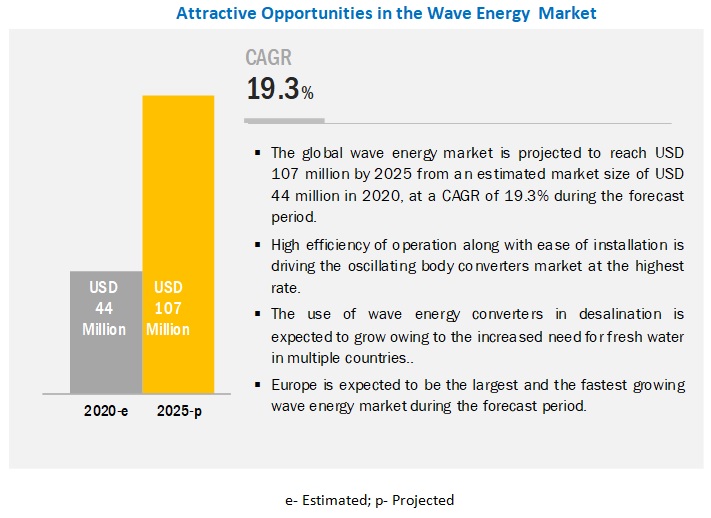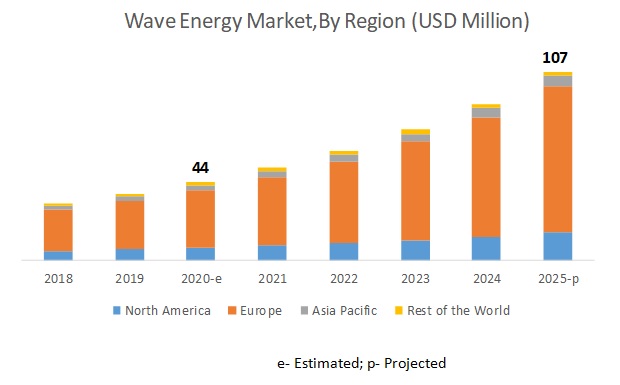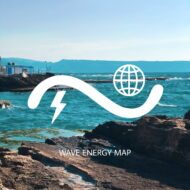Oceans and seas make up 71% of the planet’s surface
50% of the world’s population lives close to beaches
The global wave energy capacity of 80,000 terawatt hours is four times the global production of electricity
The potential of wave energy is estimated at 29 500 TWh/year (OES, 2012). With an estimated 83 340 TWh/year (300 exajoules/year), or 90 % of the global ocean energy potential (IRENA, 2014).
Global production of electricity from wave energy in 2020 does not exceed 0.05 of blind electricity production
Expectations to reach 10% of global electricity production in 2050
The global wave energy market is projected to reach USD 107 million by 2025 from an estimated market size of USD 44 million in 2020, at a CAGR of 19.3% during the forecast period. The factors driving the growth for wave energy market is due to the growing adoption for of renewable energy generation and other applications is helping manufacturers to invest more in R&D leading to the growth of wave energy market.


Wave energy economics
The capital cost per kW of establishing a wave-energy power station is likely to be at least twice that of a conventional station running on fossil fuels; and the capacity factor is likely to be lower than that of a conventional station due to the variability of the wave climate. Therefore wave energy costs can only be competitive if the running costs are significantly below those for a conventional station.
Naturally the ‘fuel’ costs are zero, leaving the operation and maintenance costs as the determining factor. Schemes will therefore have to be reliable in their energy conversion and robust enough to survive the wave climate for many years, so they will need to be designed for long lifetimes and with small numbers of moving parts (to minimise failures). The oscillating water columns and TAPCHAN schemes are good examples of what is required.
The UK Committee on Climate Change (CCC, 2011) has calculated the cost of electricity from a possible future (2030) 50 MW array of shoreline wave energy converters, with a capital cost of £2200 per kW and a life expectancy of 40 years. Using a 10% discount rate and expressed in £ (2010):
- for a low capacity factor (15%) the cost of electricity would be 29.1p kWh−1
- for a high capacity factor (22%) the cost of electricity would be 19.9p kWh−1.
These cost figures are relatively high and reflect the fact that the fixed devices cannot usually benefit from mass production as they would be purpose-built for a specific location. Also, such devices would generally operate in shallow water where there is a much reduced wave energy climate. The total capital investment required for wave energy schemes is therefore dependent on location and overall average energy conversion efficiencies. Many of the devices detailed above have average efficiencies of around 30%.
At the time of writing, the capital cost is typically around £3000–£4500 per installed kW, although the cost of particular schemes may vary markedly from this.
Large offshore schemes are technically demanding because of the high structural loads imposed by the north Atlantic wave climate. Over time there have been improvements in design, performance and construction techniques, together with rationalisation of some of the problems and a move to smaller schemes. Smaller schemes are technically simpler and less financially risky, hence the capital and insurance costs are reduced, with commensurate reduction in produced energy costs.
Wave energy technology is moving into the commercial world. Several developers are already deploying prototypes and, in some cases, executing schemes generating electricity or desalinating seawater at favourable prices. Coupled with incentives for avoided carbon dioxide emissions, the economic prospects for commercial wave energy exploitation appear good in the longer term.
As wave energy is considered to be environmentally benign (discussed in the next section), if the technology can be successfully further developed it should become an attractive commercial and political proposition, which should result in an extensive installation programme, with wave farms deployed in many locations. Refinement to designs should the cost of such installations from current levels, making them more efficient, and creating lower production costs when they are (where possible) mass-produced.
